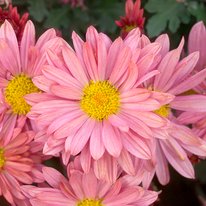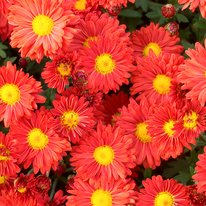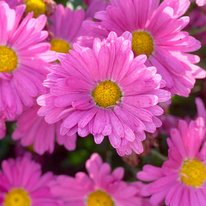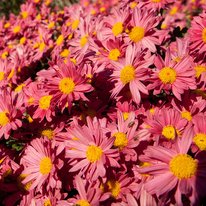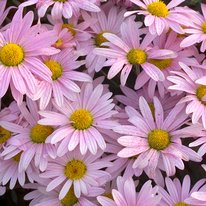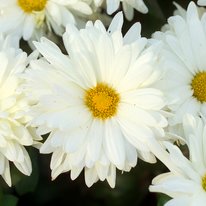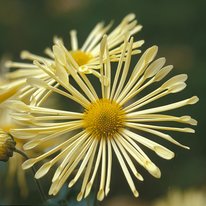A shrub plant habit denotes the large plant size each cultivar reaches in the second and successive years of growth, but like the cushion variety, the shrub cushion's surfaces will be completely covered with blooms. These plants will grow to a height and spread of 36 to 48 inches.
University of Minnesota Shrub Cushion Habit Chrysanthemum Varieties
Mammoth™ Coral Daisy
- Coral with gold center, single flowers
- Flowers are frost resistant
- Early bloom period
- Plant grows 20-36" tall, 20-48" spread
- Released in 2002
Mammoth™ Dark Bronze Daisy
- Bronze with gold center, single flowers
- Flowers are frost resistant
- Early bloom period
- Plant grows 20-36" tall, 20-48" spread
- Released in 2006
Mammoth™ Dark Pink Daisy
- Deep pink, large daisies with gold center, single flowers
- Flowers are frost tolerant
- Early bloom period
- Plant grows 20-36" tall, 20-48" spread
- Released in 2006
Mammoth™ Lavender Daisy
- Lavender with a gold center, single flowers
- Flowers are frost tolerant
- Early bloom period
- Plant grows 20-36" tall, 20-48" spread
- Released in 2006
Mammoth™ Red Daisy
- Red petals with a gold center, daisy flowers
- Flowers are frost tolerant
- Early bloom period
- Plant grows 20-36" tall, 20-48" spread
- Released in 2007
Mammoth™ Twilight Pink
- Pink with a gold center and a purple eye, single daisy flowers
- Flowers are frost tolerant
- Early bloom period
- Plant grows 20-36" tall, 20-48" spread
- Released in 2002
Mammoth™ White Daisy
- White, gold center, semi-double, daisy flowers
- Flowers are frost tolerant
- Early bloom period
- Plant grows 20-36" tall, 20-48" spread
- Released in 2002
Mammoth™ Yellow Quill
- Yellow with a gold center, single daisy, quilled petaled flowers
- Midseason bloom period
- Plant grows 20-36" tall, 20-48" spread
- Released in 2002
Mammoth™ mums were previously marketed as Maxi-Mums and My Favorite™.
Mammoth™ and My Favorite™ are trademarks of the University of Minnesota.
Plant size measurements refer to first-year plants properly spaced and grown in full sun.
Bloom period represents average state-wide appearance of first blooms. Early: Starts blooming before September 1; Midseason: September 1-15; Late: After September 15.
Commercialization and licensing
These varieties are not protected by US Plant Patent or foreign plant breeders' rights, but nurseries propagating this variety can support the U of M breeding program through an agreement with the Minnesota Nursery Research Corporation (MNRC). The Minnesota Nursery Research Corporation (MNRC) is a non-profit horticultural organization that sponsors scientific research for the commercial growing industry. Since 1957, MNRC has collected voluntary payments from propagators of U of M ornamental and fruit introductions and contributed over $2.5 million to the U of M Department of Horticultural Science. Generous MNRC participants are dedicated to supporting research science and breeding efforts. They believe in the development of cold hardy, disease resistant, prolific and profitable future cultivars and varieties.
If you are a propagator and would like to support the future of the industry by participating in MNRC, please email Pat Bailey, MNRC President, at [email protected].

